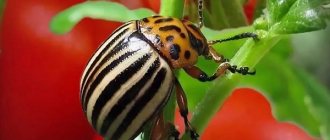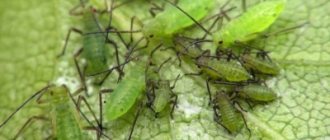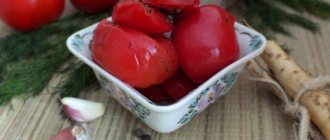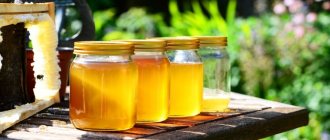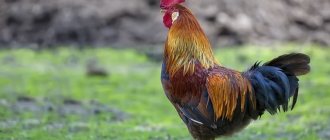Modern gardeners have made a lot of discoveries in growing maximum yields with minimal costs. And tomatoes in a barrel are one of them. This technology allows you to obtain truly stunning yields from one bush, confidently outperforming any of the known growing methods. If you are not yet familiar with this intriguing and super effective approach to gardening, read on. You will learn about the secrets and nuances of growing tomatoes in a barrel.
Photo
This is what tomatoes grown in barrels look like.
It is advisable to grow tomatoes only as seedlings
We grow tomatoes only from seedlings. The timing of sowing in open ground, a greenhouse or a greenhouse at the dacha directly depends on when vegetable seedlings are needed, because the plants will be ready for transplanting in 50-60 days. To plant it after the risk of frost has disappeared, we sow tomato seeds in a greenhouse in early April. If there is a lot of space in the greenhouse (that is, it is possible to plant seedlings at a considerable distance), we sow the seeds even earlier. Also, seeds can be sown earlier (10-14 days) if the tomatoes are covered with non-woven material or film.
Picking
Picking begins when the first leaves appear on tomato seedlings (namely leaves, not cotyledons). You can plant them in boxes at a distance of 8-10 by 10-15 cm or in small pots, which are then placed in dense rows in a greenhouse (when the seedlings grow up, the pots can be arranged). In addition, during picking, we remove all damaged plants, as well as those that have not developed leaves.
Temperature and watering
Tomatoes should always be warm in the greenhouse (16-20 degrees during the day and 14-16 at night). Short-term cold snaps (down to several degrees above 0) will not cause much harm to tomatoes, but a consistently low temperature will have a particularly negative effect on seedlings. We water it so as not to soak the leaves, and sometimes feed it with mineral fertilizers. From time to time the greenhouse needs to be ventilated. Seedlings from pots can be transplanted into the ground when their first inflorescence appears.
Transplanting tomato seedlings into soil
Before planting tomatoes, we level and fertilize the soil on the site; The more years have passed since the manure was applied, the more mineral fertilizers are required for the vegetable plot. You can reduce the dose of mineral fertilizers if you add organic fertilizers along with them. The ideal option is to grow tomatoes in the second year after applying manure.
Before transplanting, we water the tomato seedlings from the greenhouse and then cut the soil between the plants with a knife. This is done so that each specimen receives its own root ball, which will help the plant take root better.
Waxing of roots - optional
There is a recommendation to immerse the roots of vegetable seedlings first in liquid paraffin (temperature - about 53 degrees), and then in cold water. As a result, the root ball of the tomato will be covered with a layer of paraffin, thanks to which it will not crumble, but will not be delayed in development.
We take out the tomato seedlings that were grown in pots immediately before transferring them to the ground. If it was prepared in cardboard boxes or nutritional cubes, we plant it in the ground along with them.
Advantages and disadvantages
Growing tomatoes in a barrel has a lot of advantages:
- With this method, in addition to saving space, less water is spent on watering.
- Moles and other shrews will not be able to reach them.
- Since tomato bushes do not come into contact with the soil surface, their risk of infection by pests and diseases is significantly reduced.
- The barrel does not have a closed bottom, so excess water will not be retained, and worms can easily penetrate the soil.
- There is no need to build a greenhouse, because with the onset of frost the plant can be covered with film.
Important! The only disadvantage of growing tomatoes in a barrel is the impossibility of obtaining early tomato fruits. The first ones ripen around mid-summer.
Advantages of the method
The compact method of growing tomatoes in a barrel has many advantages:
- it is not necessary to install greenhouse structures using this technique, and the land area of the site is saved several times;
- the harvest from an overgrown plant at the end of the season, which is distinguished by a very powerful root system and many fruits set, increases ten times compared to the yield of the fruits of a bush planted in the ground;
- fruits, which can be collected until the end of autumn, are stored until mid-January;
- the saved space on the site is used for planting other crops for which there was no space before;
- when fresh organic matter is placed in containers for growing tomatoes, plant residues begin the process of rotting, the air temperature near the root system rises by five to six degrees, which has a beneficial effect on the active growth and development of plants;
- Having taken care of covering material for containers with tomatoes, the harvest stretches until mid-November;
- the leaves and stems of tomatoes do not come into contact with the soil, which is home to a large number of pathogenic microbes. Therefore, plants are not affected by diseases
- caring for plants in compact containers is more convenient than caring for vegetable plantings in the garden.
Preparation
Growing tomatoes in a barrel requires certain preparatory measures.:
Capacity
- The bottom of the selected barrel is removed, and 1 cm holes are made in the walls, which should be located in each 20*20 cm area. This is necessary for better oxygen supply to the roots of the tomato bushes.
- For the barrel, you need to choose a place that will be perfectly heated by the rays of the sun.
- At the very bottom you need to pour a 10-centimeter layer of urgasa - a special fertilizer prepared using EM technology. It involves the use of microorganisms that transform the soil into good arable land without artificial fertilizers and pesticides. As a result, the harvest will be much higher.
- The next layer, also 10 cm thick, will be a mixture of an equal amount:
- compost;
- ordinary soil;
- turf land.
Tomato seeds
Before planting, seeds need to be sorted . They should be:
- undamaged;
- large;
- correct shape.
Seed material from last year's harvest is excellent for seedlings. Preparing seeds for sowing consists of disinfection and soaking. Picking seedlings is done in large containers (read about how to grow tomatoes without picking here). This will allow the root system to develop better.
The following types are considered the best varieties for growing tomatoes in a barrel::
Pink giant
The bush of this mid-season tomato grows up to 1.5 m and higher. The fruits are distinguished by their large weight, juicy pulp, and sweetish taste.
Ilya Muromets
The yellow fruits of the tomato variety Ilya Muromets weigh about 300 grams. The growth of the bush reaches 2 m. Tomatoes ripen within 100 days.
De Barao
The lashes of the De Barao variety sometimes grow up to 3 m . These oval tomatoes come in different colors:
- yellow;
- red;
- black.
Reference! The variety is distinguished by its high yield, although it ripens quite late.
Tarasenko
Hybrid tomatoes Tarasenko are distinguished by their high growth. The fruits have a bright red color and a pleasant taste. You can remove about 3 kg of tomatoes from one branch. The bushes grow well in both sun and partial shade.
Scarlet Mustang
I like the Scarlet Mustang tomato variety for its interesting shape . The length of the fruit is from 10 cm to 14 cm. It is high-yielding and unpretentious in care.
Koenigsberg
Tall Koenigsberg tomatoes are quite suitable for growing in a barrel. The red, elongated fruits have a dense texture and excellent taste.
Budenovka
The Budenovka variety grows of medium size . It feels good in a barrel and produces a good harvest. These round tomatoes have thick, thin skin. When stored, fruits retain their taste for a long time.
All these varieties are distinguished by their resistance to frost and unpretentiousness.
Preparing the rest of the material
In order for the tomato tree in the barrel to become large, it is necessary to use urgasu . Its preparation takes place throughout the year.
- Take an old plastic bucket, at the bottom of which a grate is placed at a low height.
- The walls of the bucket need to be lined with a plastic bag with holes in the bottom.
- All kitchen waste is placed in it.
The liquid flowing down can be used as fertilizer for indoor flowers.
Each bookmark must be sprayed with the Baikal EM1 preparation, which contains bacteria, sprinkled with Urgasy starter, and pressed down on top with a weight wrapped in a bag. The bucket must be tightly closed.
Urgasy starter is made from rolled and dried kitchen scraps like minced meat.:
- For 1 kg of this starter you need to add 5 tbsp. l. “Baikal EM1”, then this mixture is put into a bag, and a load is placed on top.
- After 7 days, knead and dry. This mixture helps tomato bushes develop quickly.
The preparation of EM compost differs from conventional compost only in that it contains crushed components. The porosity of the mass is achieved by adding 10 kg of sawdust per 100 kg of mixture. Everything must be mixed well and each layer should be poured with a solution of the preparation EM-1 (100 ml per 10 liters of water) and 100 ml of non-acidic jam, which does not contain berries. Compost must have a moisture content of at least 60%. It can be used after 60 days.
How to plant seedlings
So, how to grow tomatoes in a barrel. First, the barrel itself is prepared:
- From 15 to 20 holes with a standard diameter of about 1 cm are made in advance. With the help of such manipulations, access to oxygen is opened in the structure.
- The bottom is removed. An open bottom throughout the tomato growing season provides free movement for the worms, which will create natural channels to get rid of excess moisture.
One common option is to mix compost, turf soil and regular soil in equal volumes. A layer of urgasy (10 cm) is placed on the bottom.
The first seedling should be placed directly in the center of the barrel in May or early June in 5-7 cm of soil and be sure to cover it with polyethylene. It provides protection from the cold at night. It would not be a bad idea to use the strongest of them as the first seedling.
Subsequent treatment is carried out when the plant reaches a height of 10 cm, and requires regular repetition until the soil mixture consisting of turf soil and compost fills the entire barrel with a small hill on top.
At this stage, the plastic film can be removed, since the root system has reached a certain development, and the tomatoes of the upcoming harvest have become able to withstand any temperature changes and other negative factors that arise.
Landing
Tomato seedlings are usually planted in mid-May.:
- After the barrel takes its place in the sun, 4-5 seedlings are planted into it at the same distance from each other to a depth of 5 cm.
- The lower leaves need to be removed.
- At night, the barrel is covered with film to prevent the plants from freezing.
- After they grow to 10 cm, soil containing nutrients is poured on top. This procedure is carried out until the barrel is completely filled with earth.
Reference! After 15 days, the root system will be able to support a large bush. During this time, the stems will become stronger and the film can be removed.
Read more about the rules and subtleties of planting tomatoes here.
How to plant tomatoes in buckets
There won’t be any special problems with planting, the main thing is to prepare the containers and substrate in advance, and the process itself is practically no different from the classic version.
Conditions in the greenhouse
The air temperature in the greenhouse should be within +25. +30 degrees, the room must be regularly ventilated. Basically, growing tomatoes in a greenhouse in buckets requires the same conditions as growing them in beds.
Did you know? In order for the immune system to function properly, it is enough to drink a glass of tomato juice (preferably freshly squeezed) every day, as it contains the daily requirement of vitamins A and C necessary for the human body.
Choosing buckets
The material from which the buckets are made does not matter; they can be plastic or metal. But the color of the planting containers plays a big role: if they are black or dark, it is better to wrap them with light cloth or paper so that the roots of the plant do not overheat.
The most interesting thing is that the older and more worn out the bucket, the better. Numerous holes and cracks contribute to the evaporation of excess moisture and ventilation of the root system.
If you are going to use new buckets for planting, you will have to work hard on them and make as many holes as possible in the bottom and along the edges of the container.
You can also plant tomatoes in buckets upside down; for this method you need containers that already have a hole in the bottom (or you need to make one specially). The diameter of the hole should be 5-10 cm.
Soil for growing
Experts recommend preparing the planting substrate in advance, in which case the results will definitely exceed all expectations.
In the fall, you need to fill the containers with humus mixed with ash and pour plenty of water over the resulting mixture, then place the containers in the greenhouse.
In winter, it is advisable to cover buckets with soil mixture with snow, so that when it melts in the spring, the soil will be thoroughly saturated with melt water.
Important! Even if it was not possible to prepare the soil in advance, it’s okay - you can plant in the same soil that you use for planting tomatoes in the beds
Landing rules
You can plant tomatoes in buckets earlier than in beds. The soil in the container warms up quickly enough, so there is no need to worry that the seedlings will freeze. One bush should be planted in each bucket.
It is better to plant cup tomatoes upside down at the end of May, this is due to the fact that this method is used mainly for decorative purposes, and they are usually hung in the open air on a summer cottage or balcony.
After the hole in the planting container is prepared, it is sealed with paper or foam plastic, this is necessary so that the plant does not fall out.
Then a seedling bush is placed in the container so that the tomato stem hangs upside down by about 5 cm, and the root of the plant is covered with planting substrate. After this, the bucket is hung by the handle in a sunny area.
Care and watering
At the beginning of summer, tomatoes growing in a barrel do not need to be pinched. It is desirable, on the contrary, to create more brushes. Most often, from 20 to 30 of them are formed, each with 8-15 ovaries. As a result of the free hanging of the lower branches and stepsons, which will gradually begin to spread along the ground, they will cover the barrel. By mid-July the bush will turn into a real tomato tree, so you need to secure it:
- trunk;
- branches;
- top shoots.
When growing tomatoes in a barrel, the bushes turn out to be powerful. They need a lot of water. Be sure to monitor the soil moisture in the barrel. It should be 60-70%. It can be determined this way: when a lump of soil is slightly squeezed, water should be released. It is difficult to pour tomatoes into a barrel; the excess will leak out because there is no bottom.
By mid-summer, the tomato bush uses almost all the beneficial substances that were placed in the barrel of soil. To feed a tomato tree, you can use a mash made from EM compost .
To prepare it you need:
- Take a container, fill a third of it in equal proportions with a soil mixture of EM compost and turf soil.
- Pour water to the top just so that there is no chlorine in it.
- Leave everything for a day.
It is recommended to water the tomato bush 2-3 times a week with this solution.
How to care for seedlings?
Watering and fertilizing
Water carefully, not abundantly, so as not to form a mess.
After the leaves appear, you can feed them with mineral fertilizers. There are special substances for this that you can buy at any garden store or prepare yourself.
- When the first cotyledon leaf appears, copper is used. Half a teaspoon of copper is dissolved in five liters of water.
- After the second leaf has appeared, urea is used to improve the quality of the green mass. To do this, take half a tablespoon of urea per five liters of water. The solution is diluted and the shoots are sprayed with it.
- Then, as soon as the third cotyledon leaf appears, you need to move on to the next stage - diving.
Picking
- Carefully remove the sprouts. If this is a vertical method, then unwind the rolls and carefully take out one sprout at a time. When growing horizontally, simply remove the sprouts from the paper.
- Next you need to transplant 2 sprouts into separate pots. Peat ones are best suited for this process.
- After this, transshipment is carried out into open ground.
Before carrying out the diving procedure, it is necessary to prepare the soil. The most suitable composition should include:
- 3 parts each of soil, peat, compost;
- 0.5 parts sand;
- 1 part wood ash.
Mix all ingredients thoroughly, steam with boiling water or bake in the oven at 200 degrees for an hour. This is how the soil is disinfected. Next, you need to leave the disinfected soil for a week so that the nutritional microflora is restored.
Before planting, add nitrophoska, which is diluted according to the instructions. This is a mineral fertilizer that strengthens growth, stimulates development and ensures a healthy harvest.
Moving into the ground
Transplantation is carried out after the appearance of three normal leaves on the stem.
- To do this, you need to dig shallow holes, pour 2-3 liters of water into each and place a bush there.
- Then sprinkle the bushes with soil. There is no need to water the bush from above after this.
- Be sure to make a hole around it so that water does not drain during watering.
Common Mistakes
- One of the common mistakes that leads to low yields is choosing the wrong tomato variety (read which tomato varieties are suitable for growing here).
- Also, you should not use fertilizers too often or too much. Tomatoes prefer fertilizers that balance three important nutritional elements:
- nitrogen;
phosphorus;
- potassium.
- A mistake is failure to comply with the watering regime. Tomatoes begin to get sick more often due to weakened immunity, the reason for this is shallow and frequent watering. If the plant is poorly watered, it will not be able to fully absorb calcium from the soil. As a result, dry dark brown spots form on the tops of the tomatoes.
If the nutrient solution contains nitrogen in high concentration, this leads to stimulation of the development of vegetative mass, negatively affecting the fruits. Fresh manure is especially destructive in this regard.
The method of growing tomatoes in a barrel is considered successful due to the rapid warming of the soil and water. This is due to the presence of limited space. Experienced gardeners advise everyone to try using this innovative technology on their site.
If you are interested in other ways to grow tomatoes, read how to do it in peat tablets and pots, as well as upside down, in bottles, buckets upside down, pots, snail methods, Chinese methods and according to Maslov.
Suitable varieties
Due to the fact that tomatoes are cultivated in containers and barrels with a volume of 100 l-200 l, indeterminate varieties and hybrids characterized by unlimited growth should be selected for planting. Good fit:
- “De Barao Giant”;
- “Galina F1”;
- “King of the big ones”;
- “King of the Early”;
- “Lucky Cross”;
- “Red Velvet”;
- “Cream Orange Giant”;
- “Bashful blush”;
- “Dad”;
- "Pink Elephant";
- “Altai honey”;
- “American creeper”;
- "Brighton Beach";
- “Vasilina.”
General information about tomato
Tomato variety VP 1 f1 was registered in Russia in 2010. The plant has passed the yield test when cultivated in open and closed ground conditions and in compliance with the technology. Both growing methods have shown good results, provided that agricultural technology recommendations and suitable climatic conditions are followed. Characteristics and external features of the plant:
- Early, the berries are ready for picking in 85–90 days.
- Indeterminate.
- Hybrid.
- Semi-open type.
- Tall, in closed ground up to 1.5 meters.
- Medium sized foliage.
- Powerful root system.
- Compact.
- Large-fruited.
- Short internodes.
- Good tolerance to stressful conditions.
- Excellent transportability.
- Storage duration is up to 20 days.
- Stable immunity to a number of diseases and viruses: Mosaic, fusarium, cladosporiosis.
- High yield, up to 130 tons per hectare of crops.
- Excellent fruit set even under unfavorable conditions.
- Not suitable for mechanical assembly.
The VP1 tomato has taken root in temperate regions due to its resistance to temperature extremes and cold resistance. The yield of the variety is not reduced by the short, cool summer season. Technical data and external features of the fruit:
- Flat-round shape.
- Dense, thin skin.
- Pink color when mature.
- There is no green spot on the stalk.
- Aligned.
- Large, weight up to 280 grams.
- Resistant to cracking and microcracks.
- The number of cameras is more than six.
- Meaty, but not watery.
- Sweet taste.
- There is no sour aftertaste.
- Persistent tomato aroma.
- Resistance to physiological problems.
- Medium density.
Ripe berries are suitable for processing. The fruits make tomato paste, juice, and sauces. The variety is suitable for pickling and preparing preparations for the winter. Fresh tomatoes are used as an ingredient for salads and stuffing.
Basic techniques
A tomato tree, which is the easiest way to grow in open ground, will give a rich harvest when using the so-called EM technology. In this case, the plant is planted in a barrel, and the harvest is harvested from the end of June to October.
The second method involves growing it in a greenhouse for one and a half years. Using this technique, a real tomato tree grows, with a crown occupying a huge area.
How to plant seedlings
In order to plant, we prepare the soil in advance and adhere to deadlines.
Failure to comply with these requirements leads to:
- yellowing of leaves;
- late blight disease;
- poor seed germination.
The soil
This tomato variety grows well on the ground after the following crops:
- cabbage;
- carrot;
- cucumber;
- zucchini;
- tomatoes (every 3 years);
- legumes
The soil is dug up in the fall, cleared of debris and cow or chicken droppings are added. You can postpone fertilizing the soil until spring. It is stored outdoors, which helps destroy viral and other agents.
Before planting, the following mixture is made:
- 1 part of land;
- 1 part compost;
- 1 part humus;
- 2 cups of ash;
- 1 tablespoon of potassium sulfate;
- 3 tbsp. l. superphosphate.
Deadlines
The seeds need to be planted in March. Depending on the region, this may be the first, second and third decades. From the moment the seeds are sown until the seedlings are ready for planting in open ground, 2 months will pass. By this time, the ambient temperature should already have reached a steady warming and should not fall below 2 degrees at night.
The video tells in detail about when and how to sow tomato seeds for seedlings. Taken from the Lyubimaya Dacha channel.
Seed preparation and planting scheme
It is advisable to plant tomato seeds after preparing them first. Otherwise, some of them may not sprout, and the plants grown from the remaining ones will not have the same resistance to weather conditions and diseases that is inherent in this variety.
Seed preparation includes three stages:
- Processing and screening.
- Nutrition.
- Hardening.
Processing and screening
This operation is performed as follows:
- Prepare a bag of gauze or cotton fabric.
- Wrap the seeds and immerse them in a manganese solution for 15 minutes. To prepare it, dissolve 5 grams of potassium permanganate in a 250 ml glass of water at room temperature. (The resulting liquid will acquire a pleasant cherry color, not darker).
- We throw away non-viable seeds; they will end up on the surface of the bag.
- The remaining seeds must be washed with running (not very cold) water.
Nutrition
When the seeds are still in the manganese solution, we make the mixture:
- 1 tsp. ash;
- 1 liter of unboiled water at room temperature.
Ash can be replaced:
- half a tablet of microelements;
- quarter tsp. sodium humate powder;
- fertilizers Nitrofoski and Nitroammofoski.
Having created such a mixture in one way or another, we immerse the seeds in it for 12 hours, then move them into ordinary water for a day. In both cases, containers with the nutrient mixture should be placed near the battery or in another warm place so that the temperature of the liquid is not lower than 24-25 degrees.
The photo shows the process of processing seeds in potassium permanganate
Hardening
To harden Dubrava tomato seeds before planting, place them in gauze (bag) for two days in a refrigerator with zero temperature (the main thing is not near the freezer). We check the fabric periodically and, if necessary, additionally moisten it.
Sowing
After completing the seed preparation procedure, they need to be sown as soon as possible. Any container with drainage holes is suitable for this. If the choice is made on boxes or similar large areas, you need to maintain the distance between the holes. It should not be less than 4 cm. The depth of each hole is up to 2 cm.
How to care for seedlings
After planting the seeds:
- Watered.
- Cover with film.
- Place in a warm place.
The film can be removed when sprouts appear.
It is recommended to water abundantly. For Dubrava, drought is more destructive than excessive watering.
Once the plants are 5-6 weeks old, we begin to harden them:
- the temperature at night should drop to 12 degrees;
- during daylight hours - until 18.
To do this we do the following:
- When growing on a windowsill or balcony, open the window for 60-120 minutes in the first days. In the greenhouses we open the doors.
- A week before planting in open ground, it is advisable to take the seedlings out into the fresh air, where they can be left for 12-24 hours.
You need to grow seedlings observing the following rules:
Picking. It is not necessary to pick the Dubrava, but some gardeners are inclined to use the procedure when the second true leaf appears. Light
It is important to protect the plant from direct sunlight until 5-6 leaves appear. Feeding. Fertilizers are applied for the first time 7-10 days after planting the seeds, the second time - after 3-4 weeks.
You can use ready-made mixtures and make them yourself.
Several recipes for feeding seedlings:
- 15 grams of magnesium sulfate per 10 liters of water (contains 16% magnesium and 10% sulfur), allowed every 10 days;
- 15 grams of mortar per 1 m2 (10 liters of water);
- 30 grams of Universal per 1 m2 (20 liters of water);
- monopotassium phosphate (contains 50% phosphorus and 33% potassium).
Flaws
There are no disadvantages to the method of growing tomatoes in barrels or large containers.
The only drawback is that the bushes begin to bear fruit later than ordinary ones. After all, in a barrel into which soil and organic matter are constantly added, the bushes will first build up the root system. Therefore, fruit formation is inhibited for 12-18 days. Important!
In order to repel tomato pests - moths and cutworms, place jars of diesel fuel on the ground in containers.
